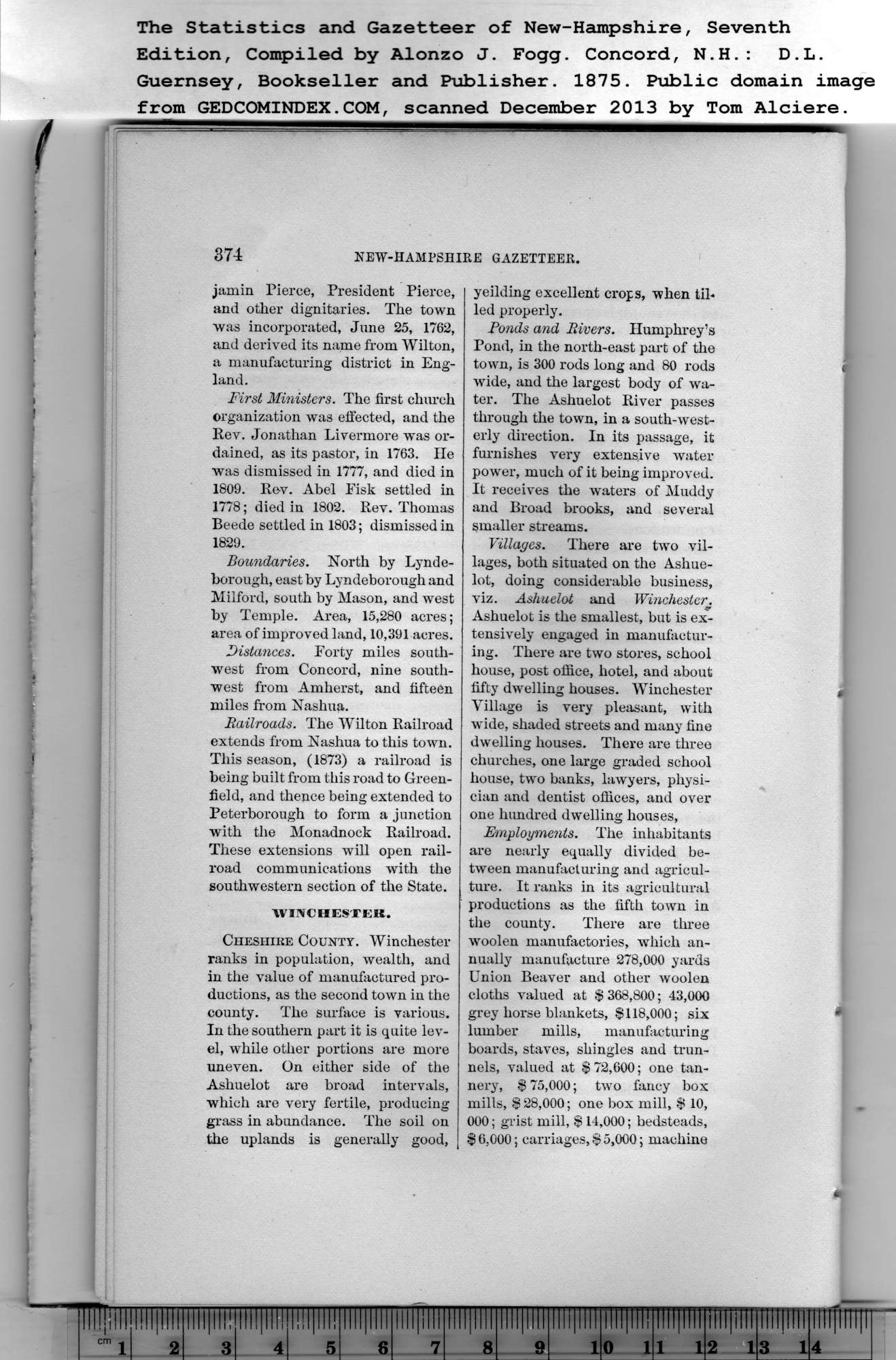|
jamin Pierce, President Pierce,
and other dignitaries. The town
was incorporated, June 25, 1762,
and derived its name from Wilton,
a manufacturing district in Eng-
land.
The Statistics and Gazetteer of New-Hampshire, Seventh
Edition, Compiled by Alonzo J. Fogg. Concord, N.H.: D.L.
374 NEW-HAMPSHIRE GAZETTEER.
First Ministers. The first church
organization was effected, and the
Rev. Jonathan Livermore was or-
dained, as its pastor, in 1763. He
was dismissed in 1777, and died in
1809. Rev. Abel Pisk settled in
1778; died in 1802. Rev. Thomas
Beede settled in 1803; dismissed in
1829.
Boundaries. North by Lynde-
borough, east by Lyndehorough and
Milford, south by Mason, and west
by Temple. Area, 15,280 acres;
area of improved land, 10,391 acres.
Distances. Forty miles south-
west from Concord, nine south-
west from Amherst, and fifteen
miles from Nashua.
Railroads. The Wilton Railroad
extends from Nashua to this town.
This season, (1873) a railroad is
being built from this road to Green-
field, and thence being extended to
Peterborough to form a junction
with the Monadnock Railroad.
These extensions will open rail-
road communications with the
southwestern section of the State.
WINCHESTER.
Cheshire County. Winchester
ranks in population, wealth, and
in the value of manufactured pro-
ductions, as the second town in the
county. The surface is various.
In the southern part it is quite lev-
el, while other portions are more
uneven. On either side of the
Ashuelot are broad intervals,
which are very fertile, producing
grass in abundance. The soil on
the uplands is generally good,
yeilding excellent crops, when til-
led properly. |
Bonds and Rivers. Humphrey’s
Pond, in the north-east part of the
town, is 300 rods long and 80 rods
wide, and the largest body of wa-
ter. The Ashuelot River passes
through the town, in a south-west-
erly direction. In its passage, it
furnishes very extensive water
power, much of it being improved.
It receives the waters of Muddy
and Broad brooks, and several
smaller streams.
Villages. There are two vil-
lages, both situated on the Ashue-
lot, doing considerable business,
viz. Ashuelot and Winchester.
Ashuelot is the smallest, but is ex-
tensively engaged in manufactur-
ing. There are two stores, school
house, post office, hotel, and about
fifty dwelling houses. Winchester
Village is very pleasant, with
wide, shaded streets and many fine
dwelling houses. There are three
churches, one large graded school
house, two banks, lawyers, physi-
cian and dentist offices, and over
one hundred dwelling houses,
Employments. The inhabitants
are nearly equally divided be-
tween manufacturing and agricul-
ture. It ranks in its agricultural
productions as the fifth town in
the county. There are three
woolen manufactories, which an-
nually manufacture 278,000 yards
Union Beaver and other woolen
cloths valued at $ 368,800 ; 43,000
grey horse blankets, $118,000; six
lumber mills, manufacturing
boards, staves, shingles and trun-
nels, valued at $ 72,600; one tan-
nery, $ 75,000; two fancy box
mills, $28,000; one box mill, $ 10,
000; grist mill, $ 14,000; bedsteads,
$6,000; carriages, $5,000; machine |
